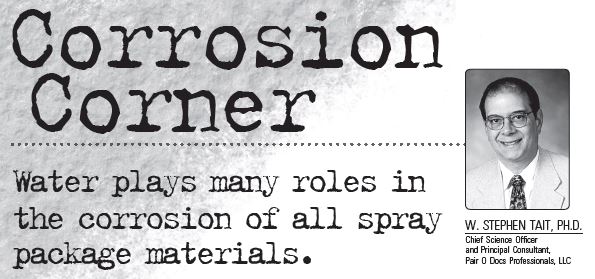Written on: September 1, 2012 by W. Stephen Tait

Hello everyone. Water is often referred to as being the closest thing to a universal solvent. It dissolves a wide range of formula ingredients and dissolves into a wide range of formula chemicals.
For example, inorganic salts and organic salts, such as sodium chloride or sodium benzoate, dissolve in water. Most gases dissolve in water, and some gases—such as carbon dioxide—react with water to form corrosive ions and molecules. DME propellant is slightly water soluble and small amounts of water will dissolve in HFC152a propellant, LPG propellants and most organic solvents.
Water-insoluble organic chemicals can be mixed with water and surfactants to form emulsions. Emulsions can be either water in oil (oil-out or W/O emulsions) or oil in water (water-out or O/W emulsions).
Corrosion Basics: water chemistry and properties relevant to spray packaging
Water molecules are composed of one oxygen and two hydrogen atoms. The valence electrons in water molecules are not equally shared between the hydrogen and oxygen atoms. Thus, one area of the water molecule is positively charged and the other area is negatively charged.
This charge-polarization of water molecules causes them to migrate to and adsorb on metal surfaces. Water’s small size allows it to absorb into and migrate through the coatings inside aerosol containers and the laminate films on metal foils. The polarized water molecule stretches the polymer chains as the water absorbs into and diffuses through a polymer, thereby creating microscopic rivers through the polymer.
Corrosion Basics: water and spray package corrosion
Water could be in your formula either as an ingredient or as a contaminant. It also disassociates into a hydrogen ion and hydroxyl ion. The hydrogen ion is electrochemically active and will remove electrons from spray package metals, thereby causing corrosion. In other words, water is potentially also a corrosive ingredient in your formula.
Water plays a lot of different roles in spray package material corrosion. For example, water molecules:
• Could be a corrosive formula ingredient
• Transport corrosive formula ingredients to the package metal
• Move ionic charges to and from the corrosion site to maintain electrical charge balance at the corrosion site and the area surrounding the corrosion site
• Hydrate metal ions formed by corrosion
• Provide hydroxyl ions that react with metal ions to form visible corrosion (i.e., the rust observed on steel aerosol containers or the black corrosion on aluminum)
• Migrate through package polymer coatings and laminate films to the package metal to cause metal corrosion and/or the coating or the laminate film to separate from the package metal (delaminate)
• Transform container coatings into semi-permeable membranes that allow only specific formula ingredients to migrate through the coating to the container metal
• Form microscopic rivers of formula ingredients in a container coating or laminate film that could subsequently cause coating delamination and/or metal corrosion
• Are a solvent for the various corrosion inhibitors used to prevent and control spray package corrosion
• Could transform non-corrosive anhydrous formulas into package-eaters
Water could simultaneously play more than one of these roles during spray package corrosion. For example, corrosion of uncoated tinplated steel corrosion involves water as follows:
1. Water reacts with aluminum oxide in the container steel to form an aluminum hydroxide gel layer on top the container surface (aluminum is used in the steel making process)
2. Water plus the aluminum hydroxide gel forms a semipermeable membrane that allows only water and specific ions to pass into, out of and through the gel
3. Iron corrosion initiates in an effort to make the chemical composition of the liquid under the gel layer the same composition as the liquid above and surrounding the gel
4. Electrons generated by corrosion under the gel move through the metal and reduce water above and around the gel layer to form hydroxyl ions
5. The electrons from corrosion also reduce electrochemically active ions and molecules in your formula
6. Water hydrates iron ions and buffers the pH under the gel to approximately four
7. A portion of the iron ions under the gel diffuse through it into your formula
8. Water transports hydroxyl ions from the edge of the gel layer to the iron ions diffusing through the gel, forming the red/brown rust seen on steel containers
9. Osmotic pressure pulls negative ions, such as chloride ions, and water into and through the gel
Stages 3–9 often occur concurrently. One can see from this example that water is simultaneously performing roles of a) initiating corrosion, b) creating a more corrosive environment, c) a media for transporting ions, d) hydrolyzing metal ions, e) corrosive molecules and f) generating hydroxyl ions that react with the hydrolyzed metal ions. Water needs to be in the liquid state to perform its various corrosion-roles, and in several instances water is consumed in a given step.
How many water molecules are needed to form liquid water? From a thermodynamic perspective it only requires around 90 water molecules to form liquid water. However, more than 90 water molecules would be needed to sustain corrosion when water is consumed during corrosion.
In addition, measurements of water layer thickness in vapor areas indicate that corrosion occurs under an approximately 30 water molecules thick layer of water. In other words, not a lot of water is needed for spray package corrosion.
Please send your questions/comments/suggestions to rustdr@pairodocspro.com or visit www.pairodocspro.com for more
information. Thanks for your interest and I’ll see you in October. Back issues of Corrosion Corner are available on CD from Spray